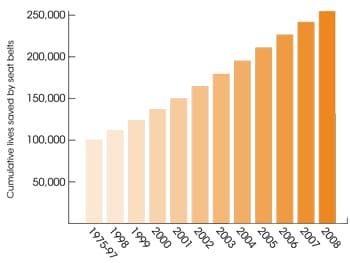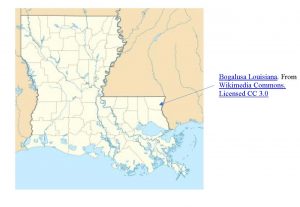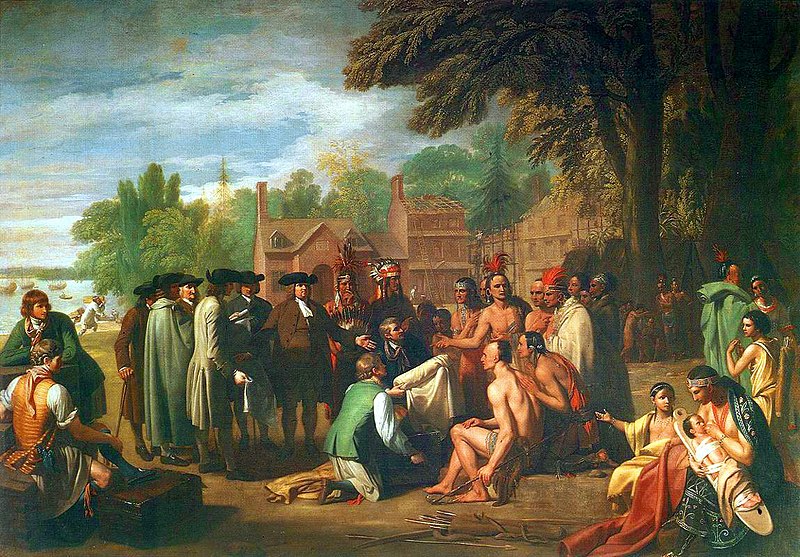Main Body
2 History of Public Health
Hector (Giovanni) Antunez
Learning Objectives
By the end of this chapter, the learner will be able to
-
Learn about the history of public health, which parallels the history of public health
- Examine the history of public health as a relatively new science
- Illustrate the history of public health with events that not only happened in the traditionally European tradition, but also in the United States, and the Americas.
- Create a history of the field of public health in the United States.
History of Public Health
Public health as a science and method of prevention did not start until recently in human society, but the main or basic concepts that created what is known as public health existed since ancient times. The concept and need for sanitation, clean water, especially drinking water, disposal of excreta. At the same time, the concept of infection, or, at least the concept that diseases might be caused by something more than supernatural sources has existed since ancient times.[1] The following are some of the documented events commonly considered part of the history of medicine and public health.
Medicine/Public health in the time of the Greeks
It is commonly accepted that the Greeks, who attributed disease causality to environmental factors influenced by the gods, the occurrence of epidemics, and the deadly toll of diseases were influenced by those factors. Also, at the time of the ancient Greeks, the concept of disease was explained by what is known as, the theory of the four ‘fluids’ (blood, phlegm, yellow bile, and black bile) that is in its turn premised on the theory of the four elements (fire, earth, water, and air) and their four corresponding qualities (heat, dry, humid and cold). [2]
 |
| Image of ‘the concepts of the four fluids/four elements’. Public Domain. Wikipedia. |
Early sanitation efforts, water systems, and toilets
The Romans developed aqueducts and sewage systems to prevent the development of diseases related to the lack of proper sanitation; bringing water to their cities improved sanitation, and personal hygiene, which are essential for good health. [3]
 |
| ‘Pont du Gard’, By Benh LIEU SONG , CC BY-SA 3.0, Wikimedia. |
It is the Romans who also developed the first rudimentary system of disposition of [pb_glossary id="202"]excretas[/pb_glossary] before what we know as toilets. [4]
 |
| ‘Ostia Toilets’(Ancient Roman latrines / latrinae), Public Domain,Wikimedia commons. |
Medieval period: The Black Death (or, Plague)
Then, the medieval period with the presence of deadly diseases such as the plague, which is considered one of the major killers in the history of humanity. [5]
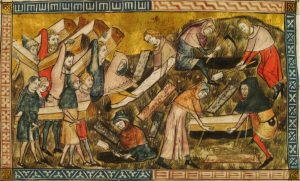 |
| ‘Citizens of Tournai bury plague victims,’ by Pierart dou Tielt, Wikimedia commons, Public Domain. |
Exercises
The Renaissance
With the advent of the sciences and arts during the Renaissance period, the initial work on medicine, and anatomic studies started. Several individuals flourished during those times, bringing new ideas, and discoveries including Girolamo Fracastoro (1478–1553), an Italian physician who introduced the term ‘fomites‘ still in use today in public health (and medicine in general) to refer to those inanimate objects that might contribute indirectly to the transmission of an infectious disease. And of course, the anatomical drawings and notes done by Leonardo DaVinci were part of the contributions from this era. [6]
 |
| Image of ‘The Renaissance man’ by Leornardo DaVinci. Public Domain. |
Medicine without microscope
If the history of medicine and public health goes back to the beginning, there is a common factor for most events (that make history), they revolved around the search for causation, and how to prevent and treat disease. Since the majority of deaths in earlier times of the human race were caused mostly by infectious agents (usually bacteria), the progress in identifying these causes had to wait until the discovery of the microscope since most of these agents could not be seen with the naked eye.[7]
 |
| ‘Old-microscopes’. Image by Idal. Wikimedia Commons. Licensed CC BY-SA 3.0 Unported |
Another major step to finding what causes disease is the work of the father of medicine
The first systematic methods used to identify causation are attributed to the father of medicine, Hippocrates who in about 400 years of the contemporary era was able to propose that there is a connection among three major elements of nature and health or disease, these are air, water, and place where people reside/live); he proposed for example that in some cases the ‘bad air’ can cause disease, or, the ‘quality of the waters’ as he called, and the place in which people live such as high altitudes and other geographical characteristics, especially the soil, and terrain. Many of these concepts are still valid. [8]
Think for a moment about the importance of the discovery of the microscope and try to imagine how medicine and public health could be done in these times without the existence of a microscope. Write down your comments.
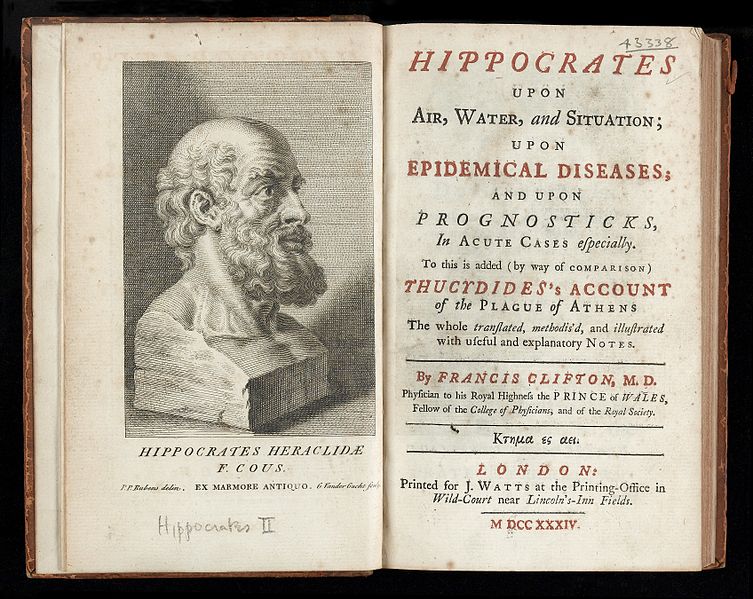 |
| ‘Hippocrates bust and title page’, image from Wikimedia Commons. Licensed CC BY 4.0 International. |
John Graunt, the first demographer
Another important person in the history of public health is, John Graunt, a London cloth merchant who lived in the middle of the 17th century. Due to his work, he is considered the first demographer and initiator of the concept of vital statistics.John Graunt In 1603 in London, Graunt compiled the first register of births and deaths in England, under the name of, the ‘Bills of Mortality’. This is considered, the first systematic recording of deaths known in the history of record keeping and reporting of deaths, and other vital events. Graunt intended to show that human life conforms to certain predictable statistical patterns, he wrote for example that deaths varied recorded age, sex, who died, of what, and where they died (location), and when (time of death). [9],[10]
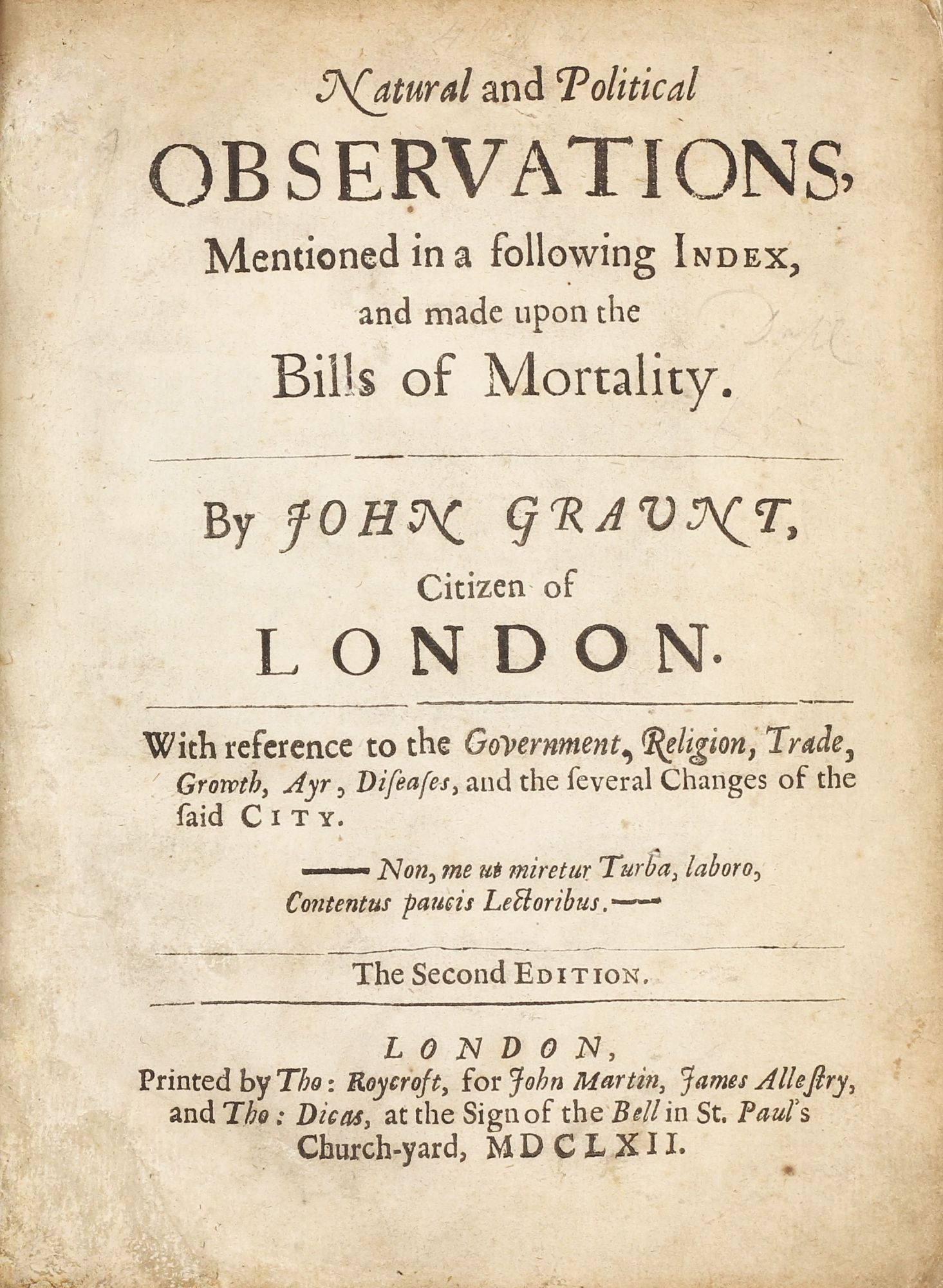 |
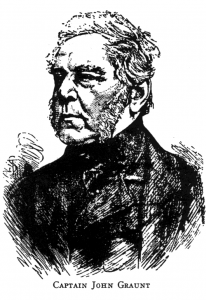 |
| ‘The Bills of Mortality’, Image from Linda Hall Library. Public Domain. | John Graunt, Image from Wikimedia Commons. Public Domain. |
William Farr, the foundations of the concept of vital statistics in public health
Another individual who made a difference in the field of public health was, William Farr, a British epidemiologist who was appointed compiler of abstracts in England, 1839.
 |
| ‘William Far’, image from Wikimedia Commons. Public Domain. |
His work examined the linkage between mortality rates and population density, it also created the foundation for the concept of vital statistics. Farr’s contributions provided foundation for classification of diseases (ICD system).[11]
John Snow: the father of public health
In the order in which events are presented here, the next person who made significant contributions to epidemiology and public health is Dr. John Snow who is considered the father of public health.
 |
| Dr. John Snow. Image from Wikimedia Commons. Public Domain. |
Dr. John Snow (1813-1858) was a respected physician, and the anesthesiologist to Queen Victoria of England, he studied cholera throughout his medical career, and from his studies, he established sound and useful epidemiological methodologies that are part of the main purposes of public health: identify the affected population, prevent, and treat them of the affected disease or health problem. He used several research methods that were highly advanced for this time, but also methods that are still valid today. Using a ‘natural experiment’ approach Dr. Snow studied an epidemic of cholera that developed in 1849 in London.
He developed a famous map (see below), that at that time was considered ‘scandalous’ because it was not drawn to scale but it provided an operational system in which he was able to identify and register where persons with cholera lived and worked, the distribution of cases were mapped using a dot map (this is considered an incipient beginning of the geographic information systems GIS map known as choropleth map ), the collected information was used by him eventually identified that the cause of the cholera epidemic was a problem with contaminated drinking water from one of the main source of water in London.
 |
| Dr. Snow’s map, image from Wikimedia Commons. Public Domain. |
Through his interventions, Dr. Snow was able to stop the cholera epidemic.[12],[13].
Exercises
As an intention to connect the history of public health in the world with the history of public health in the United States, the following covers what happened in the U.S. at almost the same period.
Cholera in the United States
During the winter of 1848-49, an outbreak of cholera was reported in New Orleans, Louisiana. A disease that had killed thousands of people in Europe had also affected the U.S. population in the South. This came after a brief epidemic of cholera in 1832. According to an article published in the famous local newspaper, The Times-Picayune, the source of the outbreak came from the contagion of locals with the arrival of a passenger ship that was bringing immigrants from Liverpool and Le Havre on December 22, 1948. In two months, the outbreak took the lives of approximately 3,000 New Orleans residents who were not prepared to deal with the contagion. The local newspaper did not realize that the cause of the disease was already known as an illness caused by contaminated water with the Vibrio Cholera bacterium; however, some locals had noted that most people affected by the outbreak were low-income individuals who lived in improper sanitary conditions, and who may have no access to clean drinking water. The cholera outbreak mentioned above has several similarities with the epidemic described by Dr. John Snow in England in 1849, people affected were those with low access to health education, and proper sanitation. The affected residents were reported as people of “irregular habits,” in the same article some numbers also reported that some of the victims of cholera were also people from Ireland, Germany, England, Spain, Prussia, France, and Switzerland. [14]
 |
| ‘The Duke of Orléans visiting the sick at the Hôtel-Dieu hospital, during the cholera outbreak, in 1832.’ Painting by Alfred Johannot, 1832. Licensed as Public Domain, from Musée Carnavalet. |
A response to the Cholera epidemic: The creation of a school of public health in New Orleans
As a student in the School of Public Health at Tulane University, New Orleans, Louisiana, I heard so many times from professors that problems such as the cholera epidemic in 1832 were one of the reasons for creating one of the first public health schools in the U.S., the Tulane School of Public Health and Tropical Medicine founded in 1834; other similar public health problems were also part of the reasons, also as part of its origins. These other health issues malaria, yellow fever, and smallpox; all of them affected the region and a group of physicians founded a medical college in New Orleans (not yet known as the School of Public Health) so training on these issues and because of the great need to education of tropical medicine problems in Louisiana and other parts of the South. [15]. See below an old (historical) picture of New Orleans:
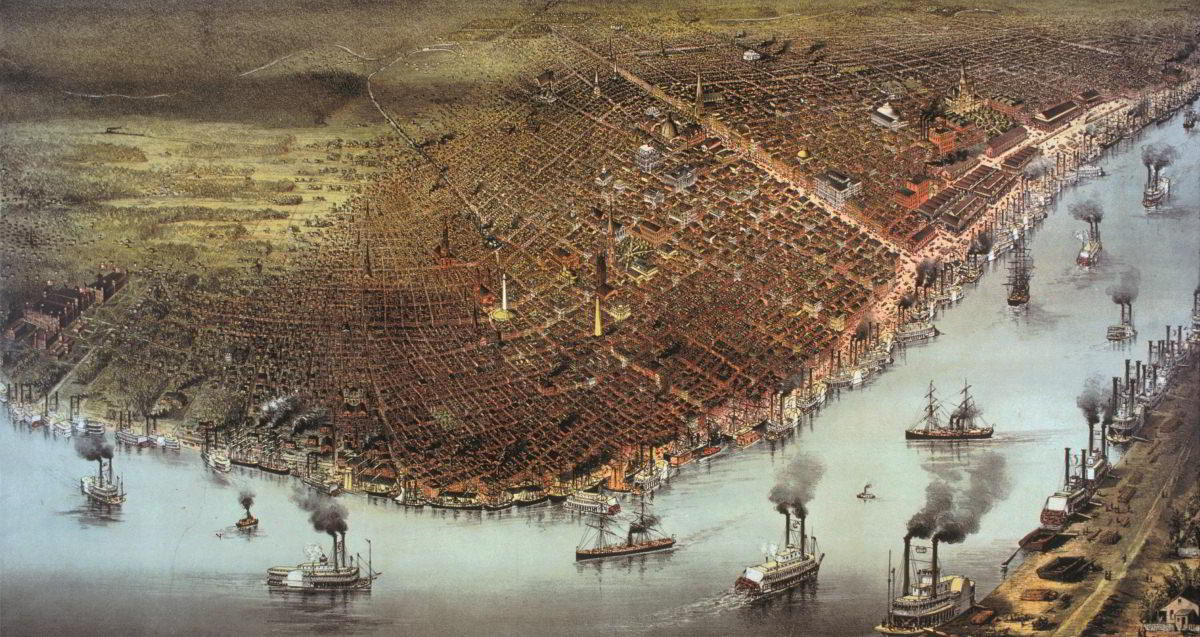 |
| “The City of New Orleans and the Mississippi River c1885” Licensed Public Domain, Library of Congress. |
More about ‘important events in the history of Public Health in the World’
Most of the events that affected the world happened (or, at least were recorded by European historians) in Europe, but those events when possible, must be also connected to the history of public health in the U.S. The following is a major discovery that affected (positively) the world:
The discoveries of Dr. Robert Koch
It is probably insufficient to have a section on historical events, or, individuals and their works without mentioning Dr. Robert Koch (1843-1910), a German physician and one of the main founders of bacteriology as a science, among other great accomplishments he discovered the anthrax disease cycle and the bacteria responsible for tuberculosis and cholera. He received the Nobel Prize for Physiology or Medicine in 1905 for his research on tuberculosis.
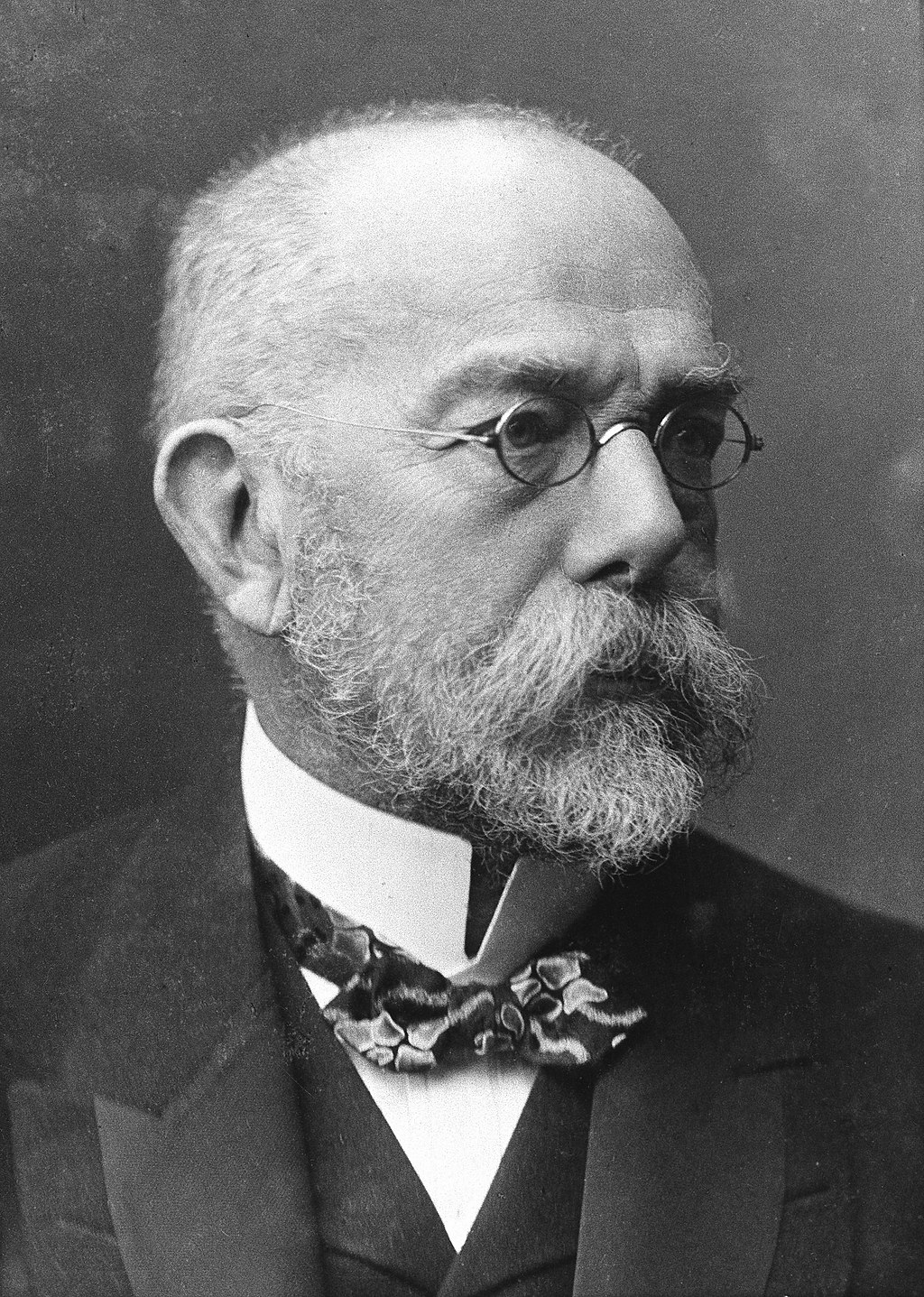 |
| Dr. Robert Koch, image from Wikimedia Commons. Public Domain. |
Dr. Koch’s work has been pivotal for the work on causation since most of the infectious diseases in his time were bacteria, or bacilli. [16]He developed what is called, the Koch postulates that include the following four criteria: (1) The microorganism must be found in diseased but not healthy individuals; (2) The microorganism must be cultured from the diseased individual; (3) Inoculation of a healthy individual with the cultured microorganism must recapitulate the disease; and finally (4) The microorganism must be re-isolated from the inoculated, diseased individual and matched to the original microorganism. These postulates are the founding for the reproducibility of experimentation with infectious agents, and the search for health determinants. [17].
Connecting the information
Cholera and Tuberculosis, why is this information important in the history of public health?
How is Dr. Koch connected to the history of the cholera epidemic mentioned above? The answer is that if Dr. Snow had access to a microscope, and also had the bacteriological knowledge that was available in the times of Dr. Koch, including his experiments with bacteria, then, Dr. Snow would not say that the contaminated water (in the time of his assessment of the cholera epidemic in London, 1849) contained a great amount of “impurity in the form of small white, flocculent particles…[visible to the naked eye]. [18] but to the presence of the Vibrio cholerae bacterium. So, although separated by decades of difference, a connection exists between Dr. Snow’s studies and Dr. Koch’s discoveries of the presence of bacilli in contaminated water.[19]
Connecting – what we have learned so far
All the above-mentioned individuals made great contributions to the field of public health. The names of more individuals could continue, but the focus of the chapter at this point will continue with the establishing of a parallel between the main influence of the public health British system on the development of public health in the United States.
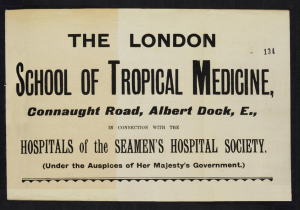 |
| “Historical poster announcing the opening of the London School of Tropical Medicine in 1899,” LSHTM, public domain. |
It is important to recall that the first school of public health in the world is the London School of Hygiene and Public Health, which for a long time, was the only school in the world, hence its main influence in the United States public health system.[20]
Before we go into more comparisons about the history of public health in the United States and Europe, it is important to mention the following individual:
The founder of the Centers for Disease Control and Prevention (CDC)
Another individual who made great contributions to the field of public health in the United States is, Dr. Alexander Langmuir, a great scientist who established CDC’s Epidemiologic Intelligence Service (EIS).
 |
| Dr. Alexander Langmuir, image from Wikimedia Commons. Public Domain. |
Dr. Langmuir made an extraordinary contribution to not only the CDC as an institution, but also to public health in general. From 1949, he served as the first Chief Epidemiologist at CDC and remained in that position until 1970. Before this, in 1952, he convened the first Conference of State and Territorial Epidemiologists, which became the organization representing epidemiologists in the United States. Overall, Dr. Langmuir defined disease surveillance at the CDC.[21]
The history of public health in the U.S. and England
What I am proposing here is that in the U.S., we start writing about our history of public health, not because the historical events of Europe (especially in England) don’t matter (because they do, they are important milestones in the history of public health in general); but because there is need to have historical information that applies to our times, and that responds to the needs of these times.
Parallel: “The Shattuck Report” in the U.S. and the progress of public health in England
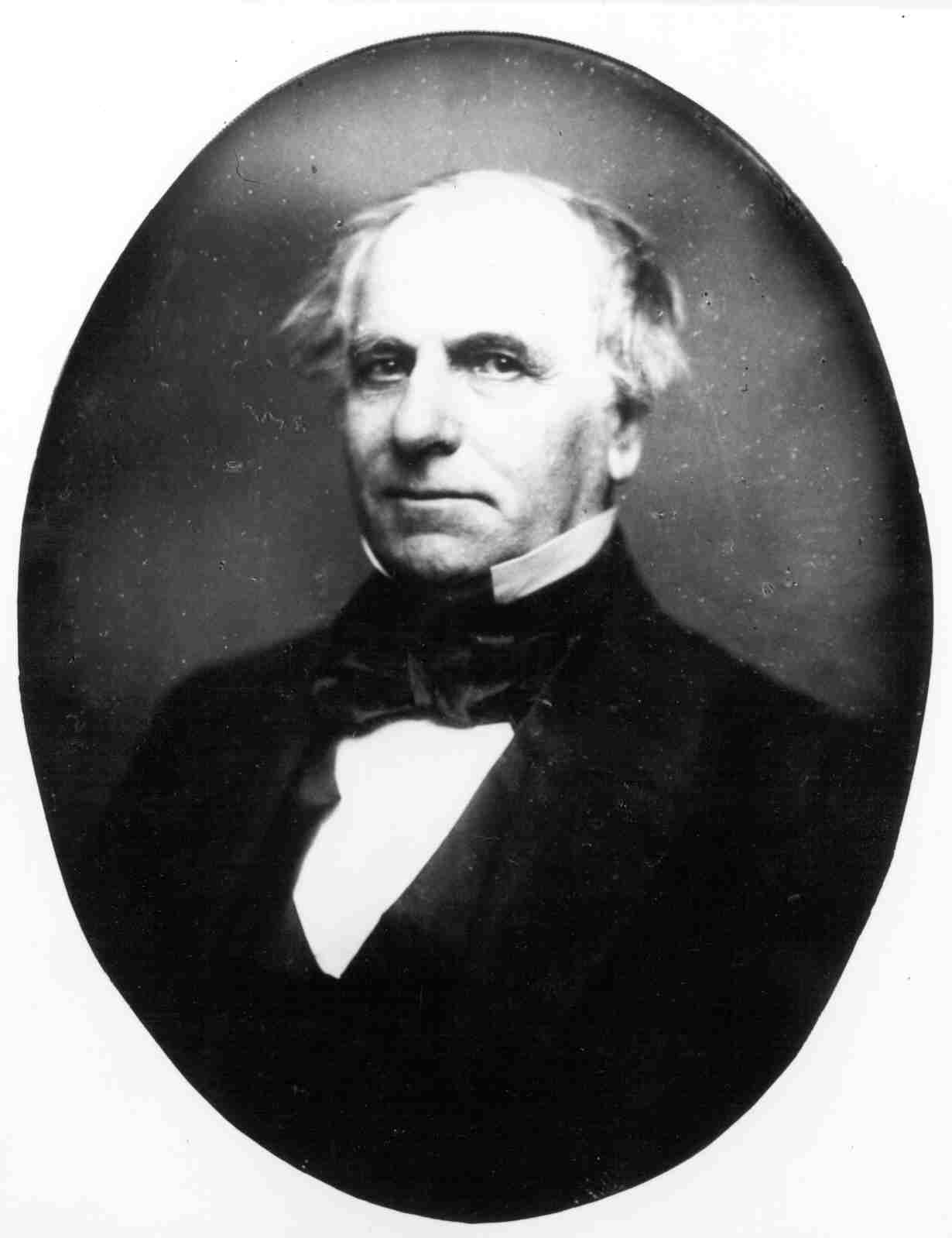 |
| Dr. Shattuck, image from London School of Hyg, & Trop. Med. |
As mentioned above, as England experienced a new beginning in public health and tropical medicine with the opening of its first public health school, the United States also experienced an event that marked the beginnings of what is essentially the public health system in the U.S., this event is the publication of the Shattuck Report, written by Dr. Lemuel Shattuck and published in 1850 by the Massachusetts Sanitary Commission. A picture of Dr. Shattuck is shown on the left.
 |
| “Shattuck’s name as it appears on the Frieze of the London School of Hygiene & Tropical Medicine.” Image By LSHTM archives – Own work, Wikimedia, Licensed CC BY-SA 4.0 |
The Shattuck’s report described the serious health problems experienced by certain groups of people, who were also living in unsanitary conditions in the city of Boston. Among the recommendations given to solve these problems, the report recommended the creation of a state health department and local boards of health in each town so public health interventions to address the issues were developed and implemented. [22],[23]
The early beginnings of public health in the U.S. contrasted so much with the reality of public health in England and France which were more concerned with how to properly administer and manage the incipient healthcare system already in place. In other words, the U.S. at that time (1850) was dealing with issues that were a thing of the past in England, or at least something that they had under control already. [24] The impact of the Shattuck’s report is another example that this country could learn from the public health lessons that England had already experienced as a country.
As a result of “The Shattuck’s” report in 1866, in New York City for the first time in the United States, a public health organizational system was created as the report recommended. This is considered by many as the beginning of public health in the U.S.
Exercises
Now, let’s look to another Parallel Dr. John Snow and Cholera (in England) and Seat belts use legislation in the U.S.
In England, Dr. John Snow (1884) used epidemiological methods to identify the cause (origin) of the cholera epidemic (a public health emergency) that was killing thousands; and also developed the strategy to stop the epidemic, which was basically removing the pump's handle of the contaminated water source; in this manner, people stopped drinking the contaminated water, and the epidemic stopped.[25] See the image of the pump below:
 |
| “John Snow pump and pub” by mrlerone is licensed under CC BY-NC-ND 2.0 |
Seat belts law in the U.S.
A similar example can be found in the U.S. when the use of seat belts started as a public health measure to save lives during motor vehicle accidents, in the early 1970s when the measures were implemented, most people did not buckle up; they thought it was optional; but with the pass of time, people started seeing the benefits of seat belt use.[26]
Seat Belts Have Saved an Estimated 255,000 Lives Since 1975 |
| Image from CDC. Public Domain. |
When the regulations are enforced, people who drive without a seat belt will get a traffic ticket from the police; and just because getting tickets is not pleasant, but also, just by knowing that the ticket is recompense for not wearing a seat belt, has made the measure very effective. And it was probably the best way to make people use (consistently) seat belts while driving; and nowadays, it has become a habit, a norm. [27].
Lesson learned: During Dr. Snow’s time in England (1884) the epidemic stopped, with he removed the water pump handle that delivered the contaminated water, in this manner, people stopped drinking from a contaminated water source. Similarly in the United States, when the seat belt law took place in the year of 1968, the use of seat belts while driving stopped the growing number of deaths associated with motor vehicle accidents; and this law continues saving lives today. People need to change behavior, but without removing barriers is hard for people to change. Laws help to enforce public health policies.
Another parallel between England and the United States is the second wave of immigrants in the U.S.
Most public health textbooks used the historical events of public health in England, and it makes sense because England’s public health history has been the standard to understand the evolution of public health, but in my opinion, this approach works well until we realize that the history of public health in the U.S. has to do with one major issue, the wave of immigrants from distant countries, and how these immigrants dealt with the current sanitary conditions, housing, and environmental conditions of their time, especially those immigrants who decided to reside in New York; which was not prepared to receive such high numbers of people, especially the unsanitary conditions of the buildings that many of these immigrants were allocated in the city, crowdedness, lack of proper disposal of excreta, and high level of cross-contamination of food, and water were typically in a for example Irish immigrant household (say, apartment) in New York.
 |
| “New York, NY, yard of tenement (between 1900 and 1910)” Image from Library of Congress. Public Domain. |
These immigrants faced a very difficult time keeping themselves healthy and alive (especially their children, who in many cases died of dysentery, or any other type of oral-fecal-related disease. [28]
These above-mentioned conditions made the public health landscape very much different from those people living in Europe (just say, in England) where more public health research was conducted at that time. So, the U.S. public health practice in this case was a little different – probably many methodological similarities, or, very different in the sense that the U.S. was experiencing a public health crisis while Europe was already ahead of the U.S. in the area of sanitary controls, and housing conditions, to mention some of the public health issues at that time.[29]
Application – the public health needs of recent immigrants to the U.S.
As the content above has presented, there is a connection between public health work and services and the growing population, in this case, the wave of immigrants mainly from Europe in New York in the early 1900s – 1910.
Parallel: tobacco use and cardiovascular disease as a public health problem in England and the United States
Another historical event (or, series of events) in the history of public health is tobacco use and its effects on health, England versus the United States. The parallel between the history of public health in England and the U.S. is the case of tobacco use and heart disease. The early regulations started earlier in England, and the English people started hearing about the noxious effects of tobacco use (mainly smoking cigarettes) way before people in the U.S., and it was not until 1957 when this country (the U.S.) became aware of the need to study (do some research) the problem, and considered for the first time to start regulations on its use, one of the main events is the released of the U.S. Surgeon General’s Advisory Committee on Smoking and Health report (on January 11, 1964) that concluded that cigarette smoking is a cause of lung cancer and laryngeal cancer in men, a probable cause of lung cancer in women, and the most important cause of chronic bronchitis.[31].
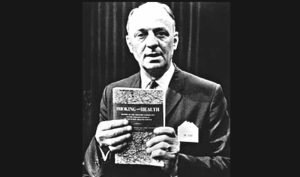 |
| Picture of the 1964 U.S. Surgeon’s General Luther L. Terry, M.D., who released the first report on the nocebo effects of smoking on health. From Medlinx, Public domain. |
Although these days, the above information about the negative effects of tobacco use on health seems something of not much importance, it represented a big step in the search for health determinants at that time. Medicine also benefited from these studies, because now, physicians and other health care providers have data from their people about the effects of chronic tobacco use and the link with overall health.
Other historical public health events in the United States: Research on Cardiovascular Disease
As described above, tobacco is a risk factor for lung disease and other morbidities, one of the most significant, heart disease, or, a group of diseases known also as cardiovascular disease. In the search for the risk factors associated with Cardiovascular disease three major cohort studies have been conducted in the United States: The Framingham Heart Study in Massachusetts, The Bogalusa Heart Study in Louisiana, and the San Antonio Heart Study in Texas. In the following paragraphs, more detailed information will be provided about these studies.
The Framingham Heart Study
It represents one of the greater milestones in public health of cardiovascular disease studies in the U.S., and it also became well-known later in the world. The Framingham Heart Study (FHS) in Massachusetts, took its name from a town in eastern Massachusetts, U.S. which was selected as the site of the study. [32] See a picture of the Framingham City Hall below:
 |
| “Town hall in Framingham, Mass.” Encyclopedia Britannica. EagleOne GNU Free Documentation License Version 1.2 |
The Framingham Heart Study is the first cohort to study the U.S. population on the issue of heart disease, and its related risk factors. It started in 1948 with a small group of individuals, and it is still collecting information about the white population in the U.S., and heart disease behavioral lifestyle risk factors. The findings of the Framingham Heart Study provided much of the common knowledge that people now have about heart disease, including the effects of exercise, diet, and smoking on cardiovascular disease. [33]
The Bogalusa Heart Study
Later in the history of public health in the U.S., there was another major study focused on cardiovascular disease; but this time on the black population, its name the Bogalusa Heart Study, Bogalusa is a city (mainly black population) in Washington Parish, Louisiana, United States. It is the principal city of the Bogalusa Micropolitan Statistical Area, which includes all of Washington Parish and is also part of the larger New Orleans–Metairie–Hammond combined statistical area. [34] See the Louisiana Map on the right
Bogalusa became well-known because of this study, which began in 1972 being the main investigator, Dr. Gerald S. Berenson, a Bogalusa native and pediatric cardiologist who recognized the need for investigations into the childhood antecedents of adult cardiovascular diseases. [35] I had the privilege to meet Dr. Berenson while doing my public health doctoral studies at Tulane University in New Orleans. [36]. To see additional images of the city of Bogalusa, see below:
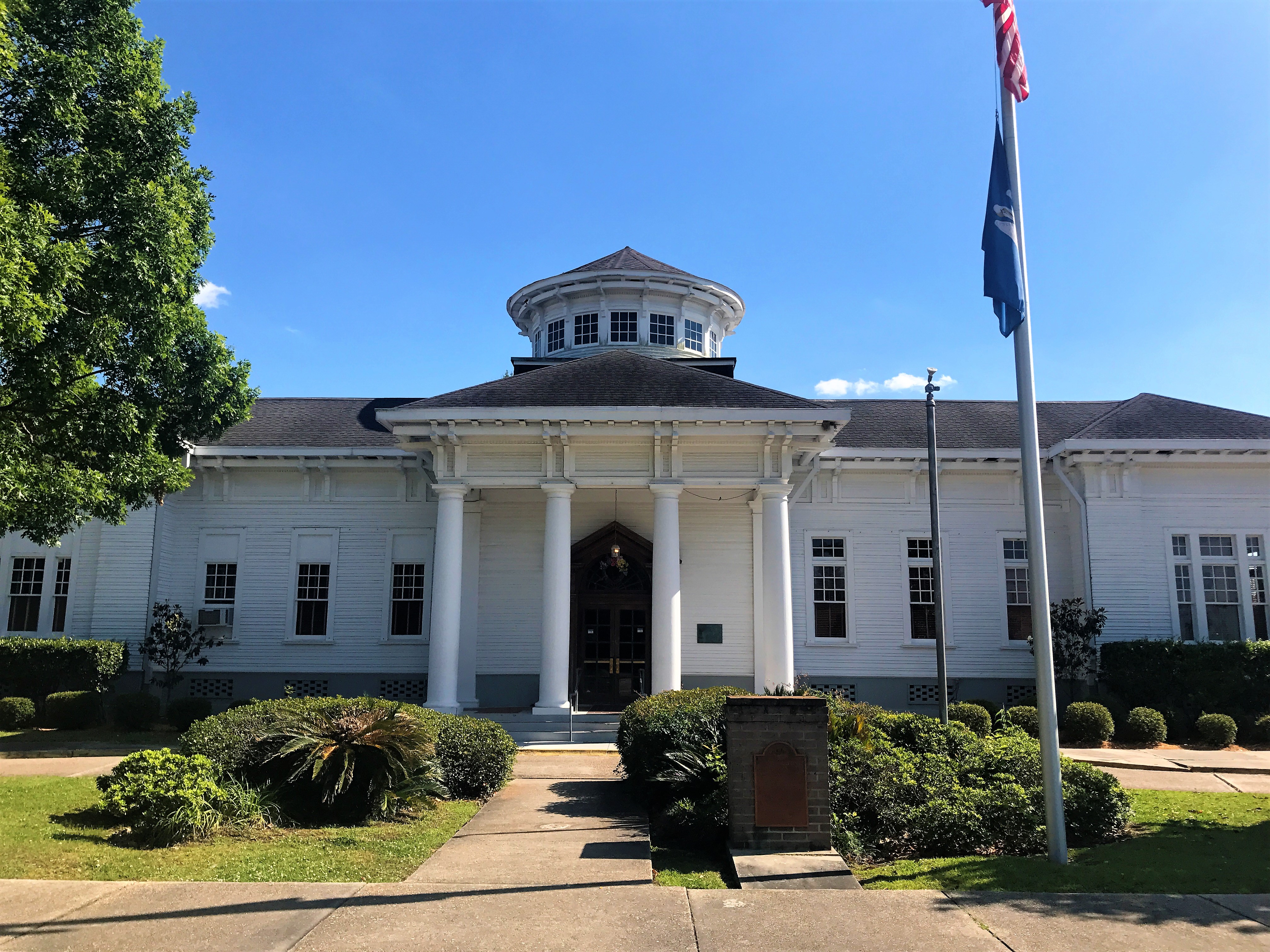 |
| “Bogalusa City Hall“. Wikimedia Commons. Licensed CC BY-SA 4.0 |
The main contributions of the Bogalusa Heart Study among others include the following: adult heart disease, atherosclerosis, coronary heart disease, and essential hypertension begin in childhood, cardiovascular risk factors can be identified in early life, but the levels of risk factors in childhood are different than those in the adult years. In addition, another great contribution of the Bogalusa Heart Study among others is that it is targeted (collected data) to African American children (while the Framingham targeted mainly adults). [37]
The next step, the San Antonio Heart Study (SAHS)
With the past of time, the need to have information (data) about cardiovascular disease among another major ethnic group in the U.S. became one of the major reasons to conduct another famous cohort study on the Latino/Hispanic population in the U.S., the name of the study, San Antonio Heart Study, San Antonio, Texas. See a picture of San Antonio below:
 |
| “Downtown San Antonio.” Wikimedia Commons. CC BY-SA 3.0 |
The San Antonio Heart study is an ongoing study that focuses not only on cardiovascular disease but also on the study of type II diabetes in Latinos residing in the U.S. The author could not find a specific website for the San Antonio Heart Study, but the following is a journal article that provides substantial information about it. [38]
My critique/comments of the San Antonio Heart study is that it lacks representativity of the different U.S. Latino ethnic groups, by being mainly focused on Mexican-Americans, which constitute a great majority of the population of Latinos in the U.S. and excluding the great numbers of new immigrants from other countries, and regions especially Central American and the Caribbean, the data results cannot be generalized to the rest of the U.S. population in the U.S., but on a positive side, the contribution of the San Antonio Heart Study (SAHS) cannot be denied because it represents pioneering research on two major problems (cardiovascular disease and type II diabetes) of morbidity, and mortality among U.S. Latino population.
What do you see are the benefits of doing cohort studies on the topic of cardiovascular health among three major ethnic groups in the United States? Elaborate your answer.
After the content covered so far in this book, there is one more issue I want to review, and it is the issue of abuses on public health research.
Public Health Research Abuses
As has been seen in the examples above, the major research efforts on the topic of cardiovascular disease in the U.S. have reflected the systemic problem of race, why some ethnic groups have been excluded from some studies? Why some ethnic groups have been lied, to and abused in some research studies? In the name of sciences and medical advances, abuses have been made. The following is an example of this type of problem.
Medical and Public Health Research going wrong in the U.S., the case of the Tuskegee syphilis study
The Tuskegee syphilis study (called at that time, the ‘Tuskegee Study of Untreated Syphilis in the Negro Male.’) took place in Macon County, Alabama during the years 1932 and 1972. During this time, a study of the natural history of syphilis was conducted among the African American population in the area. Without a person’s informed consent, the clients in the study were left without treatment for syphilis and were offered regular medical care for other health problems but not for syphilis. They were also offered free meals and burial insurance. [39]
 |
| Image from CDC Public Health Image Library (PHIL).
According to the CDC this photograph was taken around 1932, it shows participants in the Tuskegee Syphilis Study. In this picture, an African-American man was being x-rayed, while in the standing position. |
At the beginning of the study, the number of participants included 600 African American men, from this group, 399 had syphilis and 201 did not have the disease. During the time of the study, the investigators told these men that were being treated by “bad blood,” a common term at that time that was used to describe some common diseases such as syphilis, anemia, and fatigue. The study lasted for 40 years, although the men participating in the study were told that the study would last 6 months. [40]
The Tuskegee syphilis study is an example of human experimentation on the clinical history of a common infectious disease, by the time of the study there was a treatment for syphilis already available. The withholding of the treatment exposed the study participants, their families, and generations of African Americans in the South.
The Tuskegee syphilis study is frequently cited as an example of what an investigator is not supposed to do in conducting research, especially research on human subjects. The question that usually comes to mind when we read about this study is, what can be done to prevent similar situations in the future of research on human subjects in the U.S.? Elaborate your answer.
Weaponizing an infectious disease – the case of Smallpox
The first part of this topic covers the problem with smallpox in Europe, and the second part is the use of smallpox as a weapon to kill Indigenous people in the U.S.
The epidemic of smallpox in Europe and then, later in the United States
From the list of plagues that affected the world population in the past, one of the major problems is smallpox, a disease now eradicated. A disease caused by the variola virus. It caused millions of deaths especially during the Medieval times, although it is believed to have existed for at least 3000 years. [41]
 |
| “Edward Jenner (1749–1823), Public Domain, from the National Library of Medicine |
The person who created the first smallpox vaccine was Dr. Edward Jenner, an English doctor who as part of his observations noted that milkmaids who had gotten cowpox were protected from smallpox, which means that they received immunity (this concept was unknown at his time) from having the disease, this became the base for the development of the smallpox vaccine. Having a vaccine made a tremendous difference in the history of the disease, which contributed to its eradication. [42], [43]
Smallpox in the United States – a terrible experience for Native Americans
Smallpox was mainly a European problem for a long time, until the colonization of the new world (America) in which the colonizers brought the disease to the natives, which did not have immunity since they were never exposed to the smallpox agent. So, smallpox killed thousands of natives (not only in what is known as North America today but also in the Caribbean and South America.
One of the worst examples is the killing of Native Americans in the United States when the colonizer gave (as a gift, at least once) blankets intentionally contaminated with smallpox – this is also an example of an early episode of terrorism using biological weapons, as it was expected the strategy worked, and again entire populations of Native Americans were killed by the disease. [44]
World pandemics
The following section that follows covers information about the world pandemics of flu and the current COVID-19 pandemic. We want to start by looking at pandemics in the history of humanity.
Pandemics in history
The history of public health has been shaped by the presence of pandemics: plague, flu, and recently, coronavirus or, COVID-19. Throughout history, these pandemics have been responsible for the death of thousands of people around the world. Overall, what has changed from ancient times to today’s public health is the availability of vaccines, and the improvement in water and sanitation around the world, with major gains for developed nations who have better systems of drinking water, and sanitation. Until recently, the fear of a major pandemic has been for a worldwide-scale flu that could kill thousands of people. But instead of the flu, the world received the coronavirus pandemic, which is still around. Since the flu was the major fear before the coronavirus, this section will cover some of the major events of flu pandemics.
Flu pandemics
In general, flu pandemics have been repeated in history every 100 years, and because of that the ‘expected’ and ‘predicted’ pandemic was on flu (and not coronavirus). [45]. Because of its importance in history, the first major pandemic that appears usually in most history books, is the flu pandemic.
The flu pandemic of 1918
The 1918 Influenza (flu) Pandemic (also called, the Spanish flu, because of the great mortality in that country at that time). This famous pandemic lasted from 1918-1919 and killed 50 to 100 million persons worldwide. The pandemic had three waves as it is represented in the following image:
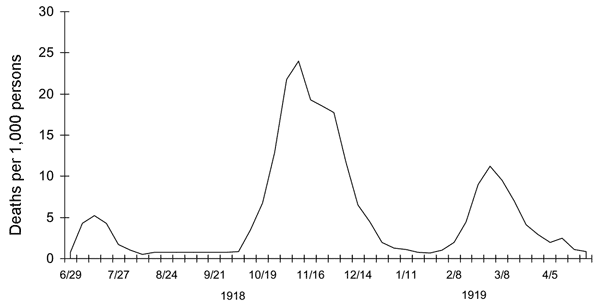 |
|
“1918 spanish flu waves,” Image Licensed Public Domain, Wikipedia. |
As is seen in the graph/image above, the second wave of the 1918 flu pandemic was higher/stronger than the first, and the third wave was also higher than the initial wave. For this reason, the 1918 flu pandemic was called, “The Mother of All Pandemics,”[46] of course this designation has been before the current coronavirus pandemic. There was also a 1927 flu pandemic that was less noticeable around the world, but it killed a significant number of people, especially army soldiers in the United States. [47]
The 2009 H1N1 influenza pandemic: a repeat of the 1919 pandemic
The specific time of this pandemic is from 2009 to 2010, the disease was first identified in the United States and eventually was named the 2009 H1N1 influenza. The first two cases of the disease were reported by the Centers for Disease Control and Prevention (CDC) in April 2009, after this, the number of cases grew to 60 million by the summer of 2010. The pandemic also attacked several other countries in the world, and it was known to prefer the group of people 14-64 years, with those aged 65 and older as the less affected group. [48], [49] This pandemic should have served as a lesson for the U.S., but a lot of skepticism grew that the possible for another major pandemic was not possible, or, if this would happen then, the country had enough public health resources including vaccines to control the problem, which has been proven wrong with the current coronavirus pandemic making manifest that the U.S. public health system was not prepared for a pandemic.
 |
The most recent pandemic: the COVID-19 pandemic due to Coronavirus 2019-current
The prediction of a new pandemic was always there but the medical and public health preparations were never in place, so, the pandemic started in Wuhan, China with several infected persons never seen before, the agent coronavirus named COVID-19 because of the year in which it was reported as the cause of the pandemic. The news was everywhere, but the United States did not pay attention to the situation, until almost two months later in March 2020; acknowledging and responding to the pandemic was proven bad, because the country and the world did not have a vaccine for it, nor the U.S. had the public health infrastructure to respond properly, there was a lot of unknown about the disease, and especially its form of transmission; the measures taken since the beginning did not have a social acceptance in a society that values so much its freedom, and having the federal government, and public health authorities, and experts tell the public to wear a mask, stay at home and related mandates created an epidemic of misinformation, and contradictory messages that have been hard to eliminate until today.[52],[53]. I have found an image -shown below that summarizes some of the reasons for this campaign of misinformation that has been one of the major problems of the COVID-19 pandemic.
 |
| “Fast-Slow-Science,” By Dasaptaerwin, Licensed CC 4.0 International, Wikimedia Commons. There is also an article that refers to more details about the content of the image.[54] |
The agent, and the statistics
As mentioned before the agent of the coronavirus has many different variants, including those variants that cause respiratory illness, called COVID-19 or, SARS-CoV-2 that may have originated in an animal (still not clear which type), and the virus mutated causing the illness in humans. [55]
| “Novel Coronavirus SARS-CoV-2 (or, COVID-19) electronic microscope image,” Licensed Public Domain,, from rawpixel. |
The number of infected people has been high since the beginning of the pandemic with excess mortality, which has been the main feature because before an infected individual died, the need for hospitalizations had been never seen in decades, and probably in the last century. The COVID-19 pandemic has officially affected 191 countries and territories in the world. Most of the data collected ranges from 2020-2021.[56] Recent estimates and reports are still only available on websites such as one of the most popular, which is from the Johns Hopkins Coronavirus Resource Center. [57]. Since the estimates are still changing, I decided to present a map of the world’s distribution of the pandemic to illustrate the content.
 |
| “Global distribution of estimated excess mortality rate due to the COVID-19 pandemic, for the cumulative period 2020–21” Image from an article by Haidong Wang, H., Paulson, KR., Pease, SA., Watson, S. et al.[58] |
At the time I completed this chapter, more and more information about the COVID-19 pandemic became available on the World Wide Web, scientific medical journals, and gray literature, especially from popular magazines, or open educational resources.
New reemerging diseases – the case of Monkeypox
Over the years, all infectious diseases lectures, books, journal publications, and articles in the news media have been talking about re-emerging infectious diseases, and there are many diseases in this category, because of its resurgence, Monkeypox has been included in this category, the disease is currently in the United States and other parts of the world is becoming a serious medical and public health issue mainly due to the lack of public health programs and infrastructure that responds to the people affected by it.
Mpox (or, Poxvirus) What is it?
Monkeypox is a disease originally found in Monkeys in 1958, although called, “Monkeypox” the source of the disease remains unknown. Rodents and non-human primates such as monkeys harbor the virus and eventually infect people. The first case of Monkeypox in humans was reported in 1970. Recently, the disease has caught the attention of the world with the recent 2022 outbreak in the United States and some sporadic cases in other parts of the world mainly in western African countries.[59]
 |
| “Monkeypox (Agent),” Image from World Health Organization (WHO), public domain. |
Agent – The disease is caused by the variola virus (a family of viruses that also causes smallpox but that is not related to chickenpox). Incubation period: most symptoms start within 3 weeks of exposure to the virus.
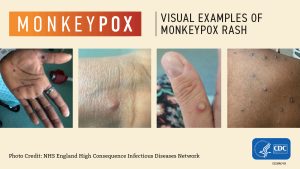 |
| “Monkeypox: Visual Examples of Monkeypox Rash,” Image from CDC [reproduced from NHS England], public domain. |
Treatment and management including vaccination: there are no specific treatments for monkeypox but because the viruses that cause smallpox and monkeypox are similar, antiviral drugs (used to treat and prevent smallpox) may be used to treat monkeypox effectively. [60], [61] Note: More and more information about Monkeypox can be found around the World Wide Web and also in medical and public journals.
The information in this chapter has been written to give an idea of the history of public health throughout two to three centuries.
This chapter has presented a historical review of events, and individuals, that had shaped the history of public health. The historical events mentioned in this chapter confirm that public health as a science has made great contributions to humanity during emergencies and daily health problems.
- Tulchinsky TH, Varavikova EA. (2014, Oct 10). A History of Public Health. The New Public Health, 1–42. From https://www.ncbi.nlm.nih.gov/pmc/articles/PMC7170188/ ↵
- Yannis T. (2009). The historical origins of the basic concepts of health promotion and education: the role of ancient Greek philosophy and medicine, Health Promotion International, 24 (2), 185–192. From https://doi.org/10.1093/heapro/dap006 ↵
- Deming D. (2020). The Aqueducts and Water Supply of Ancient Rome. Ground water, 58(1), 152–161. https://doi.org/10.1111/gwat.12958 ↵
- Gill, N.S. (August 02, 2019). Roman Baths and Hygiene in Ancient Rome. ThoughtCo. From https://www.thoughtco.com/hygiene-in-ancient-rome-and-baths-119136 ↵
- ‘Black Death,’ Wikipedia, licensed Creative Commons Attribution-ShareAlike License 3.0 URL: https://en.wikipedia.org/wiki/Black_Death ↵
- MNT Editorial Team. (Feb. 8, 2022). What was medieval and Renaissance medicine? Medical News Today (MNT). From https://www.medicalnewstoday.com/articles/323533 ↵
- Poppick, L. (March 30, 2017). Let Us Now Praise the Invention of the Microscope In Smithsonian Magazine. Available at: https://www.smithsonianmag.com/science-nature/what-we-owe-to-the-invention-microscope-180962725/ ↵
- Centers for Disease Control and Prevention (CDC). (n.d.). Lesson 1: Introduction to Epidemiology Section 2: Historical Evolution of Epidemiology. Circa 400 B.C. section. Available at https://www.cdc.gov/csels/dsepd/ss1978/lesson1/section2.html ↵
- Stephan, E. (n.d.). John Graunt (1620-1674), Observations in the Bills of Mortality. From http://www.edstephan.org/Graunt/graunt.html ↵
- Linda Hall Library. (2020, April 24). Scientist of the Day - John Graunt. From https://www.lindahall.org/john-graunt/ ↵
- Lilienfeld, DE. (2007). Celebration: William Farr (1807–1883)—an appreciation on the 200th anniversary of his birth. International Journal of Epidemiology, 36(5), 985–987. From https://academic.oup.com/ije/article/36/5/985/775018 ↵
- Kneisl, K. (February 9, 2021). John Snow, A Turning Point In Epidemiology. From https://storymaps.arcgis.com/stories/1913fb6e17cd49c88b801e4c6edb67bf ↵
- University of California Los Angeles (UCLA). (2003). Who is John Snow? UCLA Dept. of Epidemiology, Fielding School of Public Health. From http://www.ph.ucla.edu/epi/snow.html ↵
- No author. (April 23, 2020). "Careless of Cholera": The New Orleans Outbreak of 1848. The Times-Picayune. From https://www.pitothouse.org/blog/2020/4/23/careless-of-cholera-the-new-orleans-outbreak-of- 1848 ↵
- No author. (2020). History of Tulane SPHTM, a Timeline. From https://sph.tulane.edu/timeline ↵
- Wikipedia. (n.d.). Robert Koch. From https://en.wikipedia.org/wiki/Robert_Koch ↵
- Segre J. A. (2013). What does it take to satisfy Koch's postulates two centuries later? Microbial genomics and Propionibacteria acnes. The Journal of Investigative Dermatology, 133(9), 2141–2142. From https://www.ncbi.nlm.nih.gov/pmc/articles/PMC3775492/ ↵
- Snow, J. (1855). On the Mode of Communication of Cholera. From http://www.ph.ucla.edu/epi/snow/snowbook_a2.html ↵
- Rogers HR.(1895). Dr. Robert Koch and His Germ Theory of Cholera. JAMA, XXIV(23):903–904. doi:10.1001/jama.1895.024 ↵
- No author. (n.d.). London School of Hygiene and Tropical Medicine. From https://www.lshtm.ac.uk/ ↵
- Thacker, SB. (n.d.). Epidemiology and Public Health at CDC. Office of Workplace and Career Development, Office of the Director. From https://www.cdc.gov/mmwr/preview/mmwrhtml/su5502a2.htm ↵
- Report of the Sanitary Commission of Massachusetts 1850. Report available in pdf from https://www.google.com/search?client=firefox-b-1-d&q=the+shattuck+report ↵
- Winkelstein, W. (July 2008). Lemuel Shattuck Architect of American Public Health. Epidemiology, 19(4), 634. From https://journals.lww.com/epidem/Fulltext/2008/07000/Lemuel_Shattuck__Architect_of_American_Public.21.aspx ↵
- Britannica. (n.d.). National developments in the 18th and 19th centuries. From https://www.britannica.com/topic/public-health/National-developments-in-the-18th-and-19th-centuries ↵
- University of California Los Angeles (UCLA). (2003). John Snow and the Broad Street Pump. UCLA Dept. of Epidemiology. From https://www.ph.ucla.edu/epi/snow/snowcricketarticle.html ↵
- Centers for Disease Control and Prevention. (n.d.). Policy Impact: Seat Belts. From https://www.cdc.gov/transportationsafety/seatbeltbrief/index.html ↵
- Dept of Transportation (US), National Highway Traffic Safety Administration (NHTSA). (2010). Traffic Safety Facts: Seat Belt Use in 2010—Overall Results. Washington (DC): NHTSA. From http://www-nrd.nhtsa.dot.gov/Pubs/811378.pdfpdf icon ↵
- Library of Congress. (n.d.). Adaptation and Assimilation. Presentation, Immigration, and Relocation in U.S. History. From https://www.loc.gov/classroom-materials/immigration/irish/adaptation-and-assimilation/ ↵
- Markel, H., & Stern, A. M. (2002). The foreignness of germs: the persistent association of immigrants and disease in American society. The Milbank quarterly, 80(4), 757–v. https://doi.org/10.1111/1468-0009.00030 From https://www.ncbi.nlm.nih.gov/pmc/articles/PMC7152289/ ↵
- Author's comments ↵
- Centers for Disease Control and Prevention. (n.d.). History of the Surgeon General’s Reports on Smoking and Health. From https://www.cdc.gov/tobacco/data_statistics/sgr/history/index.htm ↵
- Bacallao Gallestey, J. (n.d). Framingham Heart Study research project, Framingham, Massachusetts, United States. Encyclopedia Britannica. From https://www.britannica.com/event/Framingham-Heart-Studay ↵
- No Author. (n.d.). Framingham Heart Study, Participant cohorts. Available at https://www.framinghamheartstudy.org/participants/participant-cohorts/ ↵
- Bogalusa Louisiana. From Wikipedia, https://en.wikipedia.org/wiki/Bogalusa,_Louisiana ↵
- No Author. (n.d.). Bogalusa Heart Study. Available at: https://www.clersite.org/bogalusaheartstudy/ ↵
- Personal comments from the author. ↵
- Tulane Center for Lifespan Epidemiology Research (CLER). (n.d.). Bogalusa Heart Study. Available at: https://www.clersite.org/bogalusaheartstudy/ ↵
- Shen D, Mitchell B, Hazuda H, Clark G, and Stern M. (1992). The San Antonio heart study research information study, Proceedings Computers in Cardiology, 607-610. Available at: https://ieeexplore.ieee.org/document/269385/keywords#keywords ↵
- CDC. (n.d.). The U.S. Public Health Service Syphilis Study at Tuskegee. From https://www.cdc.gov/tuskegee/index.html ↵
- National Archives of Atlanta. (n.d.). Tuskegee Syphilis Study. From https://www.archives.gov/atlanta/exhibits/item470-exh.html ↵
- World Health Organization (WHO). (No date). Smallpox. From https://www.who.int/health-topics/smallpox#tab=tab_1 ↵
- Riedel S. (2005). Edward Jenner and the history of smallpox and vaccination. Proceedings (Baylor University. Medical Center), 18(1), 21–25. https://doi.org/10.1080/08998280.2005.11928028 ↵
- CDC. (No date). History of Smallpox. From https://www.cdc.gov/smallpox/history/history.html ↵
- Kiger, PJ. (Nov 25, 2019). Did Colonists Give Infected Blankets to Native Americans as Biological Warfare? There’s evidence that British colonists in 18th-century America gave Native Americans smallpox-infected blankets at least once—but did it work? History, 15. From https://www.history.com/news/colonists-native-americans-smallpox-blankets ↵
- Kertscher, T. (April 10, 2020). Fact-check: Has a pandemic occurred every 100 years? PolitiFact. From https://www.statesman.com/story/news/politics/elections/2020/04/10/fact-check-has-pandemic-occurred-every-100-years/984128007/ ↵
- Taubenberger, J. K., & Morens, D. M. (2006). 1918 Influenza: the mother of all pandemics. Emerging infectious diseases, 12(1), 15–22. https://doi.org/10.3201/eid1201.050979 ↵
- Barry, J. M. (2020). The great influenza: The story of the deadliest pandemic in history. Penguin UK. ↵
- CDC. (no date). 2009 H1N1 Pandemic (H1N1pdm09 virus). From https://www.cdc.gov/flu/pandemic-resources/2009-h1n1-pandemic.html ↵
- Mayo Clinic Staff. (Feb 24, 2021). H1N1 flu (swine flu). From https://www.mayoclinic.org/diseases-conditions/swine-flu/symptoms-causes/syc-20378103 ↵
- Branswell, H. (June 11, 2019). The last pandemic was a ‘quiet killer.’ Ten years after swine flu, no one can predict the next one. STAT, Health. From https://www.statnews.com/2019/06/11/h1n1-swine-flu-10-years-later/ ↵
- Osterholm, MT., Kelley, NS., Manske, JM., Ballering, KS., Leighton, TR. (October 2012). CIDRAP Comprehensive Influenza Vaccine Initiative report. University of Minnesota, Academic Health Center. From https://www.cidrap.umn.edu/sites/default/files/public/downloads/ccivi_report.pdf ↵
- Tagliabue,F.,Galassi,L., Mariani,P.(2020). The “Pandemic” of Disinformation in COVID-19. SN Comprehensive Clinical Medicine, 2 (9),1287. From https://doi.org/10.1007/s42399-020-00439-1 ↵
- Grimes, DR. (March 12, 2021). Medical disinformation and the unviable nature of COVID-19 conspiracy theories. PLOS One (Pone). From https://doi.org/10.1371/journal.pone.0245900 ↵
- Dunleavy, Daniel, & Hendricks, Vincent. (2020, September 28). Fast Science, Slow Science: Finding Balance in the Time of COVID-19 and the Age of Misinformation (Version 1). Zenodo. http://doi.org/10.5281/zenodo.4056909 ↵
- Smriti Mallapaty, S. (28 January 2022). Where did Omicron come from? Three key theories with the highly transmissible variant emerged with a host of unusual mutations. Now scientists are trying to work out how it evolved. Nature. From https://www.nature.com/articles/d41586-022-00215-2 ↵
- Haidong Wang, H., Paulson, KR., Pease, SA., Watson, S. et al. (April 16, 2022). Estimating excess mortality due to the COVID-19 pandemic: a systematic analysis of COVID-19-related mortality, 2020–21. The Lancet, 399 (10334), 1513. From https://doi.org/10.1016/S0140-6736(21)02796-3 ↵
- No author. (No date). Johns Hopkins University Coronavirus Resource Center. From https://coronavirus.jhu.edu/map.html ↵
- aidong Wang, H., Paulson, KR., Pease, SA., Watson, S. et al. (April 16, 2022). Estimating excess mortality due to the COVID-19 pandemic: a systematic analysis of COVID-19-related mortality, 2020–21. The Lancet, 399 (10334), 1513. From https://doi.org/10.1016/S0140-6736(21)02796-3 ↵
- CDC. (n.d.). About Monkeypox, what is Monkeypox? From https://www.cdc.gov/poxvirus/monkeypox/about/index.html ↵
- CDC. (Sept. 19, 2022). Patient’s Guide to Monkeypox Treatment with Tecovirimat (TPOXX). From https://www.cdc.gov/poxvirus/monkeypox/if-sick/treatment.html ↵
- CDC. (October 18, 2022). Signs and Symptoms: Monkeypox symptoms. From https://www.cdc.gov/poxvirus/monkeypox/symptoms/index.html ↵
The term in general refers to sanitary conditions of the environment such as clean households, hand washing before meals, and after using the bathroom, drinking safe water, appropriate disposal of excreta - defined later in this paragraph, etc.
A term used to refer to the disposal of urine and feces mainly human.
Learning Objectives
By the end of this chapter, the learner will be able to
-
Learn about the history of public health, which parallels the history of public health
- Examine the history of public health as a relatively new science
- Illustrate the history of public health with events that not only happened in the traditionally European tradition, but also in the United States, and the Americas.
- Create a history of the field of public health in the United States.
History of Public Health
Public health as a science and method of prevention did not start until recently in human society, but the main or basic concepts that created what is known as public health existed since ancient times. The concept and need for sanitation, clean water, especially drinking water, disposal of excreta. At the same time, the concept of infection, or, at least the concept that diseases might be caused by something more than supernatural sources has existed since ancient times.[1] The following are some of the documented events commonly considered part of the history of medicine and public health.
Medicine/Public health in the time of the Greeks
It is commonly accepted that the Greeks, who attributed disease causality to environmental factors influenced by the gods, the occurrence of epidemics, and the deadly toll of diseases were influenced by those factors. Also, at the time of the ancient Greeks, the concept of disease was explained by what is known as, the theory of the four ‘fluids’ (blood, phlegm, yellow bile, and black bile) that is in its turn premised on the theory of the four elements (fire, earth, water, and air) and their four corresponding qualities (heat, dry, humid and cold). [2]
 |
| Image of 'the concepts of the four fluids/four elements'. Public Domain. Wikipedia. |
Early sanitation efforts, water systems, and toilets
The Romans developed aqueducts and sewage systems to prevent the development of diseases related to the lack of proper sanitation; bringing water to their cities improved sanitation, and personal hygiene, which are essential for good health. [3]
 |
| ‘Pont du Gard’, By Benh LIEU SONG , CC BY-SA 3.0, Wikimedia. |
It is the Romans who also developed the first rudimentary system of disposition of [pb_glossary id="202"]excretas[/pb_glossary] before what we know as toilets. [4]
 |
| ‘Ostia Toilets’(Ancient Roman latrines / latrinae), Public Domain,Wikimedia commons. |
Medieval period: The Black Death (or, Plague)
Then, the medieval period with the presence of deadly diseases such as the plague, which is considered one of the major killers in the history of humanity. [5]
 |
| 'Citizens of Tournai bury plague victims,’ by Pierart dou Tielt, Wikimedia commons, Public Domain. |
The Renaissance
With the advent of the sciences and arts during the Renaissance period, the initial work on medicine, and anatomic studies started. Several individuals flourished during those times, bringing new ideas, and discoveries including Girolamo Fracastoro (1478–1553), an Italian physician who introduced the term 'fomites' still in use today in public health (and medicine in general) to refer to those inanimate objects that might contribute indirectly to the transmission of an infectious disease. And of course, the anatomical drawings and notes done by Leonardo DaVinci were part of the contributions from this era. [6]
 |
| Image of ‘The Renaissance man’ by Leornardo DaVinci. Public Domain. |
Medicine without microscope
If the history of medicine and public health goes back to the beginning, there is a common factor for most events (that make history), they revolved around the search for causation, and how to prevent and treat disease. Since the majority of deaths in earlier times of the human race were caused mostly by infectious agents (usually bacteria), the progress in identifying these causes had to wait until the discovery of the microscope since most of these agents could not be seen with the naked eye.[7]
 |
| 'Old-microscopes'. Image by Idal. Wikimedia Commons. Licensed CC BY-SA 3.0 Unported |
Another major step to finding what causes disease is the work of the father of medicine
The first systematic methods used to identify causation are attributed to the father of medicine, Hippocrates who in about 400 years of the contemporary era was able to propose that there is a connection among three major elements of nature and health or disease, these are air, water, and place where people reside/live); he proposed for example that in some cases the 'bad air' can cause disease, or, the 'quality of the waters' as he called, and the place in which people live such as high altitudes and other geographical characteristics, especially the soil, and terrain. Many of these concepts are still valid. [8]
Think for a moment about the importance of the discovery of the microscope and try to imagine how medicine and public health could be done in these times without the existence of a microscope. Write down your comments.
 |
| ‘Hippocrates bust and title page’, image from Wikimedia Commons. Licensed CC BY 4.0 International. |
John Graunt, the first demographer
Another important person in the history of public health is, John Graunt, a London cloth merchant who lived in the middle of the 17th century. Due to his work, he is considered the first demographer and initiator of the concept of vital statistics.John Graunt In 1603 in London, Graunt compiled the first register of births and deaths in England, under the name of, the 'Bills of Mortality'. This is considered, the first systematic recording of deaths known in the history of record keeping and reporting of deaths, and other vital events. Graunt intended to show that human life conforms to certain predictable statistical patterns, he wrote for example that deaths varied recorded age, sex, who died, of what, and where they died (location), and when (time of death). [9],[10]
 |
 |
| 'The Bills of Mortality', Image from Linda Hall Library. Public Domain. | John Graunt, Image from Wikimedia Commons. Public Domain. |
William Farr, the foundations of the concept of vital statistics in public health
Another individual who made a difference in the field of public health was, William Farr, a British epidemiologist who was appointed compiler of abstracts in England, 1839.
 |
| 'William Far', image from Wikimedia Commons. Public Domain. |
His work examined the linkage between mortality rates and population density, it also created the foundation for the concept of vital statistics. Farr's contributions provided foundation for classification of diseases (ICD system).[11]
John Snow: the father of public health
In the order in which events are presented here, the next person who made significant contributions to epidemiology and public health is Dr. John Snow who is considered the father of public health.
 |
| Dr. John Snow. Image from Wikimedia Commons. Public Domain. |
Dr. John Snow (1813-1858) was a respected physician, and the anesthesiologist to Queen Victoria of England, he studied cholera throughout his medical career, and from his studies, he established sound and useful epidemiological methodologies that are part of the main purposes of public health: identify the affected population, prevent, and treat them of the affected disease or health problem. He used several research methods that were highly advanced for this time, but also methods that are still valid today. Using a 'natural experiment' approach Dr. Snow studied an epidemic of cholera that developed in 1849 in London.
He developed a famous map (see below), that at that time was considered 'scandalous' because it was not drawn to scale but it provided an operational system in which he was able to identify and register where persons with cholera lived and worked, the distribution of cases were mapped using a dot map (this is considered an incipient beginning of the geographic information systems GIS map known as choropleth map ), the collected information was used by him eventually identified that the cause of the cholera epidemic was a problem with contaminated drinking water from one of the main source of water in London.
 |
| Dr. Snow's map, image from Wikimedia Commons. Public Domain. |
Through his interventions, Dr. Snow was able to stop the cholera epidemic.[12],[13].
As an intention to connect the history of public health in the world with the history of public health in the United States, the following covers what happened in the U.S. at almost the same period.
Cholera in the United States
During the winter of 1848-49, an outbreak of cholera was reported in New Orleans, Louisiana. A disease that had killed thousands of people in Europe had also affected the U.S. population in the South. This came after a brief epidemic of cholera in 1832. According to an article published in the famous local newspaper, The Times-Picayune, the source of the outbreak came from the contagion of locals with the arrival of a passenger ship that was bringing immigrants from Liverpool and Le Havre on December 22, 1948. In two months, the outbreak took the lives of approximately 3,000 New Orleans residents who were not prepared to deal with the contagion. The local newspaper did not realize that the cause of the disease was already known as an illness caused by contaminated water with the Vibrio Cholera bacterium; however, some locals had noted that most people affected by the outbreak were low-income individuals who lived in improper sanitary conditions, and who may have no access to clean drinking water. The cholera outbreak mentioned above has several similarities with the epidemic described by Dr. John Snow in England in 1849, people affected were those with low access to health education, and proper sanitation. The affected residents were reported as people of "irregular habits," in the same article some numbers also reported that some of the victims of cholera were also people from Ireland, Germany, England, Spain, Prussia, France, and Switzerland. [14]
 |
| 'The Duke of Orléans visiting the sick at the Hôtel-Dieu hospital, during the cholera outbreak, in 1832.' Painting by Alfred Johannot, 1832. Licensed as Public Domain, from Musée Carnavalet. |
A response to the Cholera epidemic: The creation of a school of public health in New Orleans
As a student in the School of Public Health at Tulane University, New Orleans, Louisiana, I heard so many times from professors that problems such as the cholera epidemic in 1832 were one of the reasons for creating one of the first public health schools in the U.S., the Tulane School of Public Health and Tropical Medicine founded in 1834; other similar public health problems were also part of the reasons, also as part of its origins. These other health issues malaria, yellow fever, and smallpox; all of them affected the region and a group of physicians founded a medical college in New Orleans (not yet known as the School of Public Health) so training on these issues and because of the great need to education of tropical medicine problems in Louisiana and other parts of the South. [15]. See below an old (historical) picture of New Orleans:
 |
| "The City of New Orleans and the Mississippi River c1885" Licensed Public Domain, Library of Congress. |
More about 'important events in the history of Public Health in the World'
Most of the events that affected the world happened (or, at least were recorded by European historians) in Europe, but those events when possible, must be also connected to the history of public health in the U.S. The following is a major discovery that affected (positively) the world:
The discoveries of Dr. Robert Koch
It is probably insufficient to have a section on historical events, or, individuals and their works without mentioning Dr. Robert Koch (1843-1910), a German physician and one of the main founders of bacteriology as a science, among other great accomplishments he discovered the anthrax disease cycle and the bacteria responsible for tuberculosis and cholera. He received the Nobel Prize for Physiology or Medicine in 1905 for his research on tuberculosis.
 |
| Dr. Robert Koch, image from Wikimedia Commons. Public Domain. |
Dr. Koch's work has been pivotal for the work on causation since most of the infectious diseases in his time were bacteria, or bacilli. [16]He developed what is called, the Koch postulates that include the following four criteria: (1) The microorganism must be found in diseased but not healthy individuals; (2) The microorganism must be cultured from the diseased individual; (3) Inoculation of a healthy individual with the cultured microorganism must recapitulate the disease; and finally (4) The microorganism must be re-isolated from the inoculated, diseased individual and matched to the original microorganism. These postulates are the founding for the reproducibility of experimentation with infectious agents, and the search for health determinants. [17].
Connecting the information
Cholera and Tuberculosis, why is this information important in the history of public health?
How is Dr. Koch connected to the history of the cholera epidemic mentioned above? The answer is that if Dr. Snow had access to a microscope, and also had the bacteriological knowledge that was available in the times of Dr. Koch, including his experiments with bacteria, then, Dr. Snow would not say that the contaminated water (in the time of his assessment of the cholera epidemic in London, 1849) contained a great amount of "impurity in the form of small white, flocculent particles...[visible to the naked eye]. [18] but to the presence of the Vibrio cholerae bacterium. So, although separated by decades of difference, a connection exists between Dr. Snow’s studies and Dr. Koch’s discoveries of the presence of bacilli in contaminated water.[19]
Connecting - what we have learned so far
All the above-mentioned individuals made great contributions to the field of public health. The names of more individuals could continue, but the focus of the chapter at this point will continue with the establishing of a parallel between the main influence of the public health British system on the development of public health in the United States.
 |
| "Historical poster announcing the opening of the London School of Tropical Medicine in 1899," LSHTM, public domain. |
It is important to recall that the first school of public health in the world is the London School of Hygiene and Public Health, which for a long time, was the only school in the world, hence its main influence in the United States public health system.[20]
Before we go into more comparisons about the history of public health in the United States and Europe, it is important to mention the following individual:
The founder of the Centers for Disease Control and Prevention (CDC)
Another individual who made great contributions to the field of public health in the United States is, Dr. Alexander Langmuir, a great scientist who established CDC’s Epidemiologic Intelligence Service (EIS).
 |
| Dr. Alexander Langmuir, image from Wikimedia Commons. Public Domain. |
Dr. Langmuir made an extraordinary contribution to not only the CDC as an institution, but also to public health in general. From 1949, he served as the first Chief Epidemiologist at CDC and remained in that position until 1970. Before this, in 1952, he convened the first Conference of State and Territorial Epidemiologists, which became the organization representing epidemiologists in the United States. Overall, Dr. Langmuir defined disease surveillance at the CDC.[21]
The history of public health in the U.S. and England
What I am proposing here is that in the U.S., we start writing about our history of public health, not because the historical events of Europe (especially in England) don't matter (because they do, they are important milestones in the history of public health in general); but because there is need to have historical information that applies to our times, and that responds to the needs of these times.
Parallel: "The Shattuck Report" in the U.S. and the progress of public health in England
 |
| Dr. Shattuck, image from London School of Hyg, & Trop. Med. |
As mentioned above, as England experienced a new beginning in public health and tropical medicine with the opening of its first public health school, the United States also experienced an event that marked the beginnings of what is essentially the public health system in the U.S., this event is the publication of the Shattuck Report, written by Dr. Lemuel Shattuck and published in 1850 by the Massachusetts Sanitary Commission. A picture of Dr. Shattuck is shown on the left.
 |
| "Shattuck's name as it appears on the Frieze of the London School of Hygiene & Tropical Medicine." Image By LSHTM archives - Own work, Wikimedia, Licensed CC BY-SA 4.0 |
The Shattuck's report described the serious health problems experienced by certain groups of people, who were also living in unsanitary conditions in the city of Boston. Among the recommendations given to solve these problems, the report recommended the creation of a state health department and local boards of health in each town so public health interventions to address the issues were developed and implemented. [22],[23]
The early beginnings of public health in the U.S. contrasted so much with the reality of public health in England and France which were more concerned with how to properly administer and manage the incipient healthcare system already in place. In other words, the U.S. at that time (1850) was dealing with issues that were a thing of the past in England, or at least something that they had under control already. [24] The impact of the Shattuck's report is another example that this country could learn from the public health lessons that England had already experienced as a country.
As a result of “The Shattuck’s” report in 1866, in New York City for the first time in the United States, a public health organizational system was created as the report recommended. This is considered by many as the beginning of public health in the U.S.
Now, let's look to another Parallel Dr. John Snow and Cholera (in England) and Seat belts use legislation in the U.S.
In England, Dr. John Snow (1884) used epidemiological methods to identify the cause (origin) of the cholera epidemic (a public health emergency) that was killing thousands; and also developed the strategy to stop the epidemic, which was basically removing the pump's handle of the contaminated water source; in this manner, people stopped drinking the contaminated water, and the epidemic stopped.[25] See the image of the pump below:
 |
| "John Snow pump and pub" by mrlerone is licensed under CC BY-NC-ND 2.0 |
Seat belts law in the U.S.
A similar example can be found in the U.S. when the use of seat belts started as a public health measure to save lives during motor vehicle accidents, in the early 1970s when the measures were implemented, most people did not buckle up; they thought it was optional; but with the pass of time, people started seeing the benefits of seat belt use.[26]
Seat Belts Have Saved an Estimated 255,000 Lives Since 1975 |
| Image from CDC. Public Domain. |
When the regulations are enforced, people who drive without a seat belt will get a traffic ticket from the police; and just because getting tickets is not pleasant, but also, just by knowing that the ticket is recompense for not wearing a seat belt, has made the measure very effective. And it was probably the best way to make people use (consistently) seat belts while driving; and nowadays, it has become a habit, a norm. [27].
Lesson learned: During Dr. Snow's time in England (1884) the epidemic stopped, with he removed the water pump handle that delivered the contaminated water, in this manner, people stopped drinking from a contaminated water source. Similarly in the United States, when the seat belt law took place in the year of 1968, the use of seat belts while driving stopped the growing number of deaths associated with motor vehicle accidents; and this law continues saving lives today. People need to change behavior, but without removing barriers is hard for people to change. Laws help to enforce public health policies.
Another parallel between England and the United States is the second wave of immigrants in the U.S.
Most public health textbooks used the historical events of public health in England, and it makes sense because England's public health history has been the standard to understand the evolution of public health, but in my opinion, this approach works well until we realize that the history of public health in the U.S. has to do with one major issue, the wave of immigrants from distant countries, and how these immigrants dealt with the current sanitary conditions, housing, and environmental conditions of their time, especially those immigrants who decided to reside in New York; which was not prepared to receive such high numbers of people, especially the unsanitary conditions of the buildings that many of these immigrants were allocated in the city, crowdedness, lack of proper disposal of excreta, and high level of cross-contamination of food, and water were typically in a for example Irish immigrant household (say, apartment) in New York.
 |
| "New York, NY, yard of tenement (between 1900 and 1910)" Image from Library of Congress. Public Domain. |
These immigrants faced a very difficult time keeping themselves healthy and alive (especially their children, who in many cases died of dysentery, or any other type of oral-fecal-related disease. [28]
These above-mentioned conditions made the public health landscape very much different from those people living in Europe (just say, in England) where more public health research was conducted at that time. So, the U.S. public health practice in this case was a little different - probably many methodological similarities, or, very different in the sense that the U.S. was experiencing a public health crisis while Europe was already ahead of the U.S. in the area of sanitary controls, and housing conditions, to mention some of the public health issues at that time.[29]
Application - the public health needs of recent immigrants to the U.S.
As the content above has presented, there is a connection between public health work and services and the growing population, in this case, the wave of immigrants mainly from Europe in New York in the early 1900s - 1910.
Parallel: tobacco use and cardiovascular disease as a public health problem in England and the United States
Another historical event (or, series of events) in the history of public health is tobacco use and its effects on health, England versus the United States. The parallel between the history of public health in England and the U.S. is the case of tobacco use and heart disease. The early regulations started earlier in England, and the English people started hearing about the noxious effects of tobacco use (mainly smoking cigarettes) way before people in the U.S., and it was not until 1957 when this country (the U.S.) became aware of the need to study (do some research) the problem, and considered for the first time to start regulations on its use, one of the main events is the released of the U.S. Surgeon General’s Advisory Committee on Smoking and Health report (on January 11, 1964) that concluded that cigarette smoking is a cause of lung cancer and laryngeal cancer in men, a probable cause of lung cancer in women, and the most important cause of chronic bronchitis.[31].
 |
| Picture of the 1964 U.S. Surgeon's General Luther L. Terry, M.D., who released the first report on the nocebo effects of smoking on health. By CDC. Public domain. |
Although these days, the above information about the negative effects of tobacco use on health seems something of not much importance, it represented a big step in the search for health determinants at that time. Medicine also benefited from these studies, because now, physicians and other health care providers have data from their people about the effects of chronic tobacco use and the link with overall health.
Other historical public health events in the United States: Research on Cardiovascular Disease
As described above, tobacco is a risk factor for lung disease and other morbidities, one of the most significant, heart disease, or, a group of diseases known also as cardiovascular disease. In the search for the risk factors associated with Cardiovascular disease three major cohort studies have been conducted in the United States: The Framingham Heart Study in Massachusetts, The Bogalusa Heart Study in Louisiana, and the San Antonio Heart Study in Texas. In the following paragraphs, more detailed information will be provided about these studies.
The Framingham Heart Study
It represents one of the greater milestones in public health of cardiovascular disease studies in the U.S., and it also became well-known later in the world. The Framingham Heart Study (FHS) in Massachusetts, took its name from a town in eastern Massachusetts, U.S. which was selected as the site of the study. [32] See a picture of the Framingham City Hall below:
 |
| "Town hall in Framingham, Mass." Encyclopedia Britannica. EagleOne GNU Free Documentation License Version 1.2 |
The Framingham Heart Study is the first cohort to study the U.S. population on the issue of heart disease, and its related risk factors. It started in 1948 with a small group of individuals, and it is still collecting information about the white population in the U.S., and heart disease behavioral lifestyle risk factors. The findings of the Framingham Heart Study provided much of the common knowledge that people now have about heart disease, including the effects of exercise, diet, and smoking on cardiovascular disease. [33]
The Bogalusa Heart Study
Later in the history of public health in the U.S., there was another major study focused on cardiovascular disease; but this time on the black population, its name the Bogalusa Heart Study, Bogalusa is a city (mainly black population) in Washington Parish, Louisiana, United States. It is the principal city of the Bogalusa Micropolitan Statistical Area, which includes all of Washington Parish and is also part of the larger New Orleans–Metairie–Hammond combined statistical area. [34] See the Louisiana Map on the right
Bogalusa became well-known because of this study, which began in 1972 being the main investigator, Dr. Gerald S. Berenson, a Bogalusa native and pediatric cardiologist who recognized the need for investigations into the childhood antecedents of adult cardiovascular diseases. [35] I had the privilege to meet Dr. Berenson while doing my public health doctoral studies at Tulane University in New Orleans. [36]. To see additional images of the city of Bogalusa, see below:
 |
| "Bogalusa City Hall". Wikimedia Commons. Licensed CC BY-SA 4.0 |
The main contributions of the Bogalusa Heart Study among others include the following: adult heart disease, atherosclerosis, coronary heart disease, and essential hypertension begin in childhood, cardiovascular risk factors can be identified in early life, but the levels of risk factors in childhood are different than those in the adult years. In addition, another great contribution of the Bogalusa Heart Study among others is that it is targeted (collected data) to African American children (while the Framingham targeted mainly adults). [37]
The next step, the San Antonio Heart Study (SAHS)
With the past of time, the need to have information (data) about cardiovascular disease among another major ethnic group in the U.S. became one of the major reasons to conduct another famous cohort study on the Latino/Hispanic population in the U.S., the name of the study, San Antonio Heart Study, San Antonio, Texas. See a picture of San Antonio below:
 |
| "Downtown San Antonio." Wikimedia Commons. CC BY-SA 3.0 |
The San Antonio Heart study is an ongoing study that focuses not only on cardiovascular disease but also on the study of type II diabetes in Latinos residing in the U.S. The author could not find a specific website for the San Antonio Heart Study, but the following is a journal article that provides substantial information about it. [38]
My critique/comments of the San Antonio Heart study is that it lacks representativity of the different U.S. Latino ethnic groups, by being mainly focused on Mexican-Americans, which constitute a great majority of the population of Latinos in the U.S. and excluding the great numbers of new immigrants from other countries, and regions especially Central American and the Caribbean, the data results cannot be generalized to the rest of the U.S. population in the U.S., but on a positive side, the contribution of the San Antonio Heart Study (SAHS) cannot be denied because it represents pioneering research on two major problems (cardiovascular disease and type II diabetes) of morbidity, and mortality among U.S. Latino population.
What do you see are the benefits of doing cohort studies on the topic of cardiovascular health among three major ethnic groups in the United States? Elaborate your answer.
After the content covered so far in this book, there is one more issue I want to review, and it is the issue of abuses on public health research.
Public Health Research Abuses
As has been seen in the examples above, the major research efforts on the topic of cardiovascular disease in the U.S. have reflected the systemic problem of race, why some ethnic groups have been excluded from some studies? Why some ethnic groups have been lied, to and abused in some research studies? In the name of sciences and medical advances, abuses have been made. The following is an example of this type of problem.
Medical and Public Health Research going wrong in the U.S., the case of the Tuskegee syphilis study
The Tuskegee syphilis study (called at that time, the 'Tuskegee Study of Untreated Syphilis in the Negro Male.') took place in Macon County, Alabama during the years 1932 and 1972. During this time, a study of the natural history of syphilis was conducted among the African American population in the area. Without a person's informed consent, the clients in the study were left without treatment for syphilis and were offered regular medical care for other health problems but not for syphilis. They were also offered free meals and burial insurance. [39]
 |
| Image from CDC Public Health Image Library (PHIL).
According to the CDC this photograph was taken around 1932, it shows participants in the Tuskegee Syphilis Study. In this picture, an African-American man was being x-rayed, while in the standing position. |
At the beginning of the study, the number of participants included 600 African American men, from this group, 399 had syphilis and 201 did not have the disease. During the time of the study, the investigators told these men that were being treated by "bad blood," a common term at that time that was used to describe some common diseases such as syphilis, anemia, and fatigue. The study lasted for 40 years, although the men participating in the study were told that the study would last 6 months. [40]
The Tuskegee syphilis study is an example of human experimentation on the clinical history of a common infectious disease, by the time of the study there was a treatment for syphilis already available. The withholding of the treatment exposed the study participants, their families, and generations of African Americans in the South.
The Tuskegee syphilis study is frequently cited as an example of what an investigator is not supposed to do in conducting research, especially research on human subjects. The question that usually comes to mind when we read about this study is, what can be done to prevent similar situations in the future of research on human subjects in the U.S.? Elaborate your answer.
Weaponizing an infectious disease - the case of Smallpox
The first part of this topic covers the problem with smallpox in Europe, and the second part, the use of smallpox as a weapon to kill Indigenous people in the U.S.
The epidemic of smallpox in Europe and then, later in the United States
From the list of plagues that affected the world population in the past, one of the major problems is smallpox, a disease now eradicated. A disease caused by the variola virus. It caused millions of deaths especially during the Medieval times, although it is believed to have existed for at least 3000 years. [41]
 |
| "Edward Jenner (1749–1823), Public Domain, from the National Library of Medicine |
The person who created the first smallpox vaccine was Dr. Edward Jenner, an English doctor who as part of his observations noted that milkmaids who had gotten cowpox were protected from smallpox, which means that they received immunity (this concept was unknown at his time) from having the disease, this became the base for the development of the smallpox vaccine. Having a vaccine made a tremendous difference in the history of the disease, which contributed to its eradication. [42], [43]
Smallpox in the United States - a terrible experience for Native Americans
Smallpox was mainly a European problem for a long time, until the colonization of the new world (America) in which the colonizers brought the disease to the natives, which did not have immunity since they were never exposed to the smallpox agent. So, smallpox killed thousands of natives (not only in what is known as North America today but also in the Caribbean and South America.
One of the worst examples is the killing of Native Americans in the United States when the colonizer gave (as a gift, at least once) blankets intentionally contaminated with smallpox - this is also an example of an early episode of terrorism using biological weapons, as it was expected the strategy worked, and again entire populations of Native Americans were killed by the disease. [44]
World pandemics
The following section that follows covers information about the world pandemics of flu and the current COVID-19 pandemic. We want to start by looking at pandemics in the history of humanity.
Pandemics in history
The history of public health has been shaped by the presence of pandemics: plague, flu, and recently, coronavirus or, COVID-19. Throughout history, these pandemics have been responsible for the death of thousands of people around the world. Overall, what has changed from ancient times to today's public health is the availability of vaccines, and the improvement in water and sanitation around the world, with major gains for developed nations who have better systems of drinking water, and sanitation. Until recently, the fear of a major pandemic has been for a worldwide-scale flu that could kill thousands of people. But instead of the flu, the world received the coronavirus pandemic, which is still around. Since the flu was the major fear before the coronavirus, this section will cover some of the major events of flu pandemics.
Flu pandemics
In general, flu pandemics have been repeated in history every 100 years, and because of that the 'expected' and 'predicted' pandemic was on flu (and not coronavirus). [45]. Because of its importance in history, the first major pandemic that appears usually in most history books, is the flu pandemic.
The flu pandemic of 1918
The 1918 Influenza (flu) Pandemic (also called, the Spanish flu, because of the great mortality in that country at that time). This famous pandemic lasted from 1918-1919 and killed 50 to 100 million persons worldwide. The pandemic had three waves as it is represented in the following image:
 |
|
"1918 spanish flu waves," Image Licensed Public Domain, Wikipedia. |
As is seen in the graph/image above, the second wave of the 1918 flu pandemic was higher/stronger than the first, and the third wave was also higher than the initial wave. For this reason, the 1918 flu pandemic was called, "The Mother of All Pandemics,"[46] of course this designation has been before the current coronavirus pandemic. There was also a 1927 flu pandemic that was less noticeable around the world, but it killed a significant number of people, especially army soldiers in the United States. [47]
The 2009 H1N1 influenza pandemic: a repeat of the 1919 pandemic
The specific time of this pandemic is from 2009 to 2010, the disease was first identified in the United States and eventually was named the 2009 H1N1 influenza. The first two cases of the disease were reported by the Centers for Disease Control and Prevention (CDC) in April 2009, after this, the number of cases grew to 60 million by the summer of 2010. The pandemic also attacked several other countries in the world, and it was known to prefer the group of people 14-64 years, with those aged 65 and older as the less affected group. [48], [49] This pandemic should have served as a lesson for the U.S., but a lot of skepticism grew that the possible for another major pandemic was not possible, or, if this would happen then, the country had enough public health resources including vaccines to control the problem, which has been proven wrong with the current coronavirus pandemic making manifest that the U.S. public health system was not prepared for a pandemic.
 |
The most recent pandemic: the COVID-19 pandemic due to Coronavirus 2019-current
The prediction of a new pandemic was always there but the medical and public health preparations were never in place, so, the pandemic started in Wuhan, China with several infected persons never seen before, the agent coronavirus named COVID-19 because of the year in which it was reported as the cause of the pandemic. The news was everywhere, but the United States did not pay attention to the situation, until almost two months later in March 2020; acknowledging and responding to the pandemic was proven bad, because the country and the world did not have a vaccine for it, nor the U.S. had the public health infrastructure to respond properly, there was a lot of unknown about the disease, and especially its form of transmission; the measures taken since the beginning did not have a social acceptance in a society that values so much its freedom, and having the federal government, and public health authorities, and experts tell the public to wear a mask, stay at home and related mandates created an epidemic of misinformation, and contradictory messages that have been hard to eliminate until today.[52],[53]. I have found an image -shown below that summarizes some of the reasons for this campaign of misinformation that has been one of the major problems of the COVID-19 pandemic.
 |
| "Fast-Slow-Science," By Dasaptaerwin, Licensed CC 4.0 International, Wikimedia Commons. There is also an article that refers to more details about the content of the image.[54] |
The agent, and the statistics
As mentioned before the agent of the coronavirus has many different variants, including those variants that cause respiratory illness, called COVID-19 or, SARS-CoV-2 that may have originated in an animal (still not clear which type), and the virus mutated causing the illness in humans. [55]
| "Novel Coronavirus SARS-CoV-2 (or, COVID-19) electronic microscope image," Licensed Public Domain,, from rawpixel. |
The number of infected people has been high since the beginning of the pandemic with excess mortality, which has been the main feature because before an infected individual died, the need for hospitalizations had been never seen in decades, and probably in the last century. The COVID-19 pandemic has officially affected 191 countries and territories in the world. Most of the data collected ranges from 2020-2021.[56] Recent estimates and reports are still only available on websites such as one of the most popular, which is from the Johns Hopkins Coronavirus Resource Center. [57]. Since the estimates are still changing, I decided to present a map of the world’s distribution of the pandemic to illustrate the content.
 |
| "Global distribution of estimated excess mortality rate due to the COVID-19 pandemic, for the cumulative period 2020–21" Image from an article by Haidong Wang, H., Paulson, KR., Pease, SA., Watson, S. et al.[58] |
At the time I completed this chapter, more and more information about the COVID-19 pandemic became available on the World Wide Web, scientific medical journals, and gray literature, especially from popular magazines, or open educational resources.
New reemerging diseases - the case of Monkeypox
Over the years, all infectious diseases lectures, books, journal publications, and articles in the news media have been talking about re-emerging infectious diseases, many of the diseases in this category include ---- list most common diseases in this category, and one of those is Monkeypox, which currently in the United States and other parts of the world is becoming a serious medical and public health issue mainly due to the lack of public health programs and infrastructure that responds to the people affected by it.
Mpox (or, Poxvirus) What is it?
Monkeypox is a disease originally found in Monkeys in 1958, although called, "Monkeypox" the source of the disease remains unknown. Rodents and non-human primates such as monkeys harbor the virus and eventually infect people. The first case of Monkeypox in humans was reported in 1970. Recently, the disease has caught the attention of the world with the recent 2022 outbreak in the United States and some sporadic cases in other parts of the world mainly in western African countries.[59]
 |
| “Monkeypox (Agent),” Image from World Health Organization (WHO), public domain. |
Agent - The disease is caused by the variola virus (a family of virus that also causes smallpox but that is not related to chickenpox). Incubation period: most symptoms starts within 3 weeks of exposure to the virus.
 |
| “Monkeypox: Visual Examples of Monkeypox Rash,” Image from CDC [reproduced from NHS England], public domain. |
Treatment and management including vaccination: there are no specific treatments for monkeypox but because the viruses that cause smallpox and monkeypox are similar, antiviral drugs (used to treat and prevent smallpox) may be used to treat monkeypox effectively. [60], [61] Note: More and more information about Monkeypox can be found around the World Wide Web and also in medical and public journals.
The information in this chapter has been written to give an idea of the history of public health throughout two to three centuries.
This chapter has presented a historical review of events, and individuals, that had shaped the history of public health. The historical events mentioned in this chapter confirm that public health as a science has made great contributions to humanity during emergencies and daily health problems.
Inanimate objects considered to be transmitters of disease. For example, diapers in a daycare; or handkerchiefs used by a person with common cold, etc.
Consider the first demographer.
He is considered the father of vital statistics.
He is considered the father of public health.
this is considered the major action: if people don't listen to the education messages, then, remove the source of infection - although effective method at that time, it does not work so easily in the modern world, but the idea is there.
In this context, it means living for example in crowded conditions such as having a less number of beds for a larger family, so more than 2 persons sleeping in a bed, or, sharing other areas in an apartment, or, small house.
negative effect.
cohort refers to a group of individuals that are followed by a specific period of time to check on the development of disease based on risk factors associated with the disease on study.
This is probably the best term to refer to Native Americans, although most people used this latter term in their writing and conversations.
Mpox has become a preferred term, replacing monkeypox.
Carry the virus and also transmit it.
The same as the cause of the disease, it can be virus, bacteria, fungi, and others.
A family of virus that causes among others smallpox, but it is not related to chickenpox.
